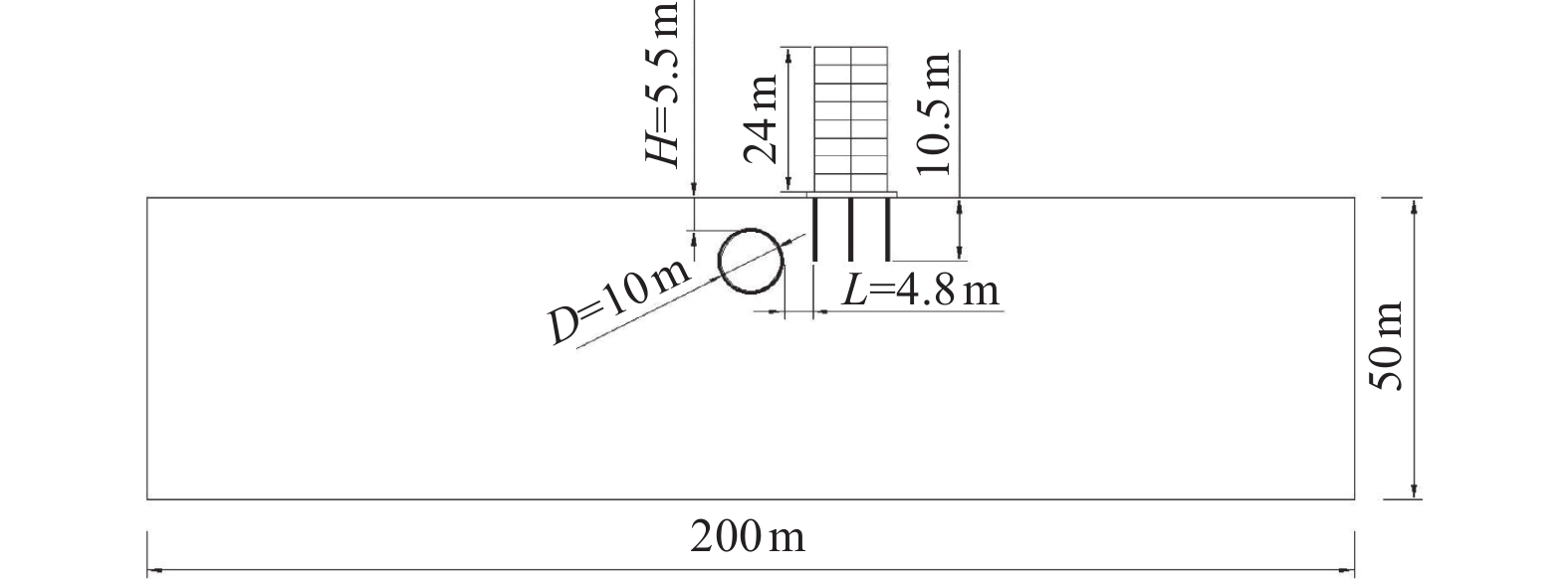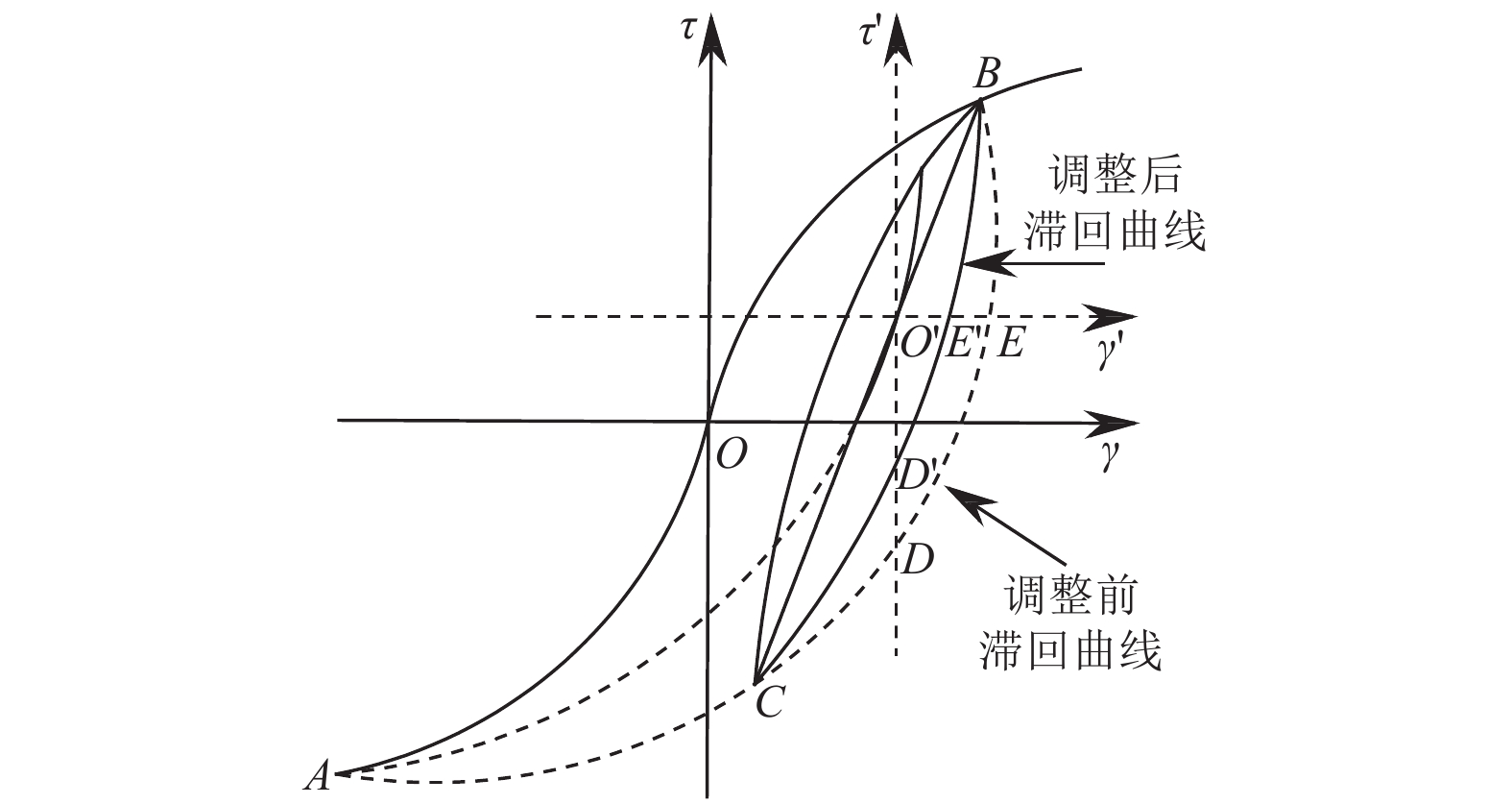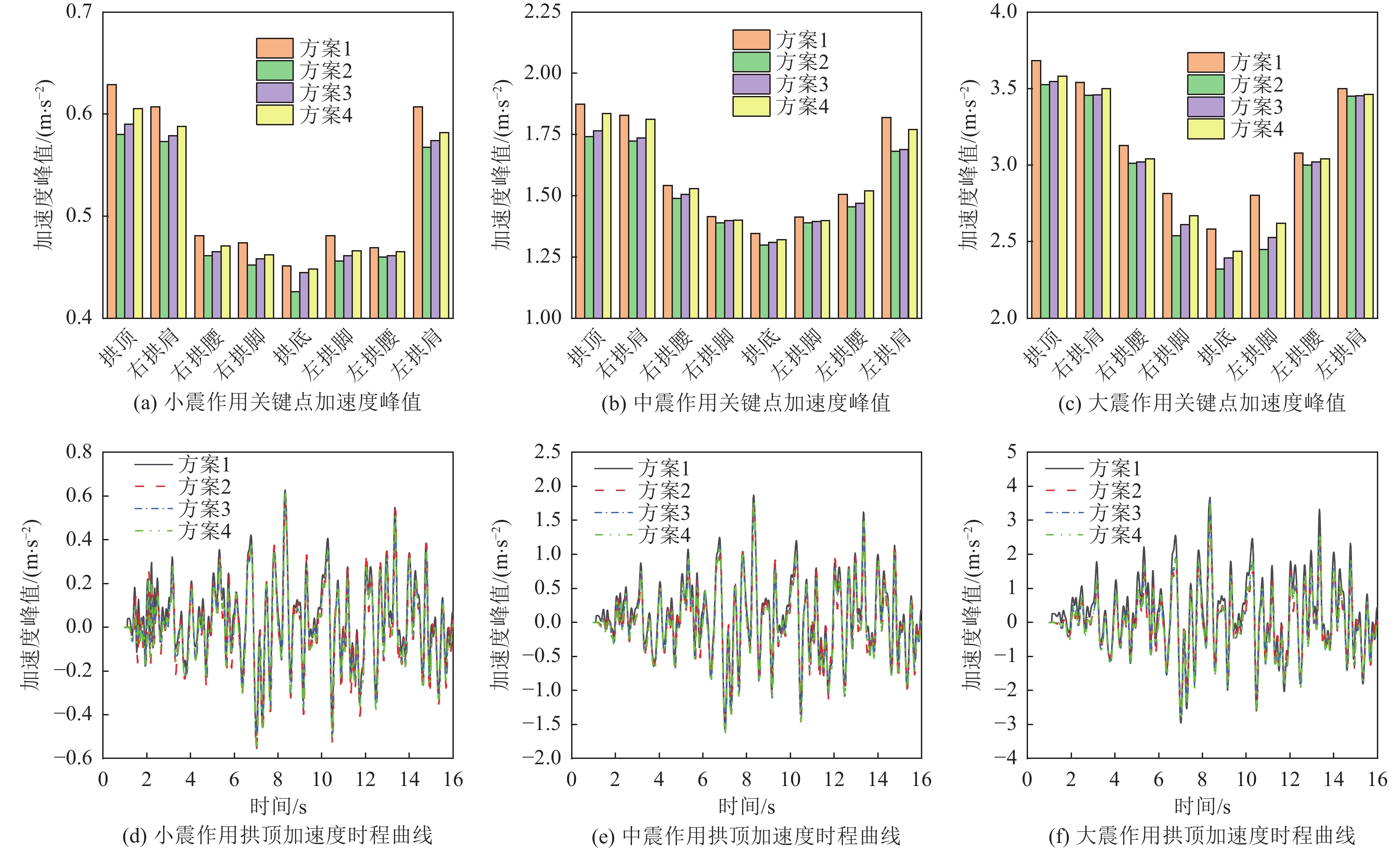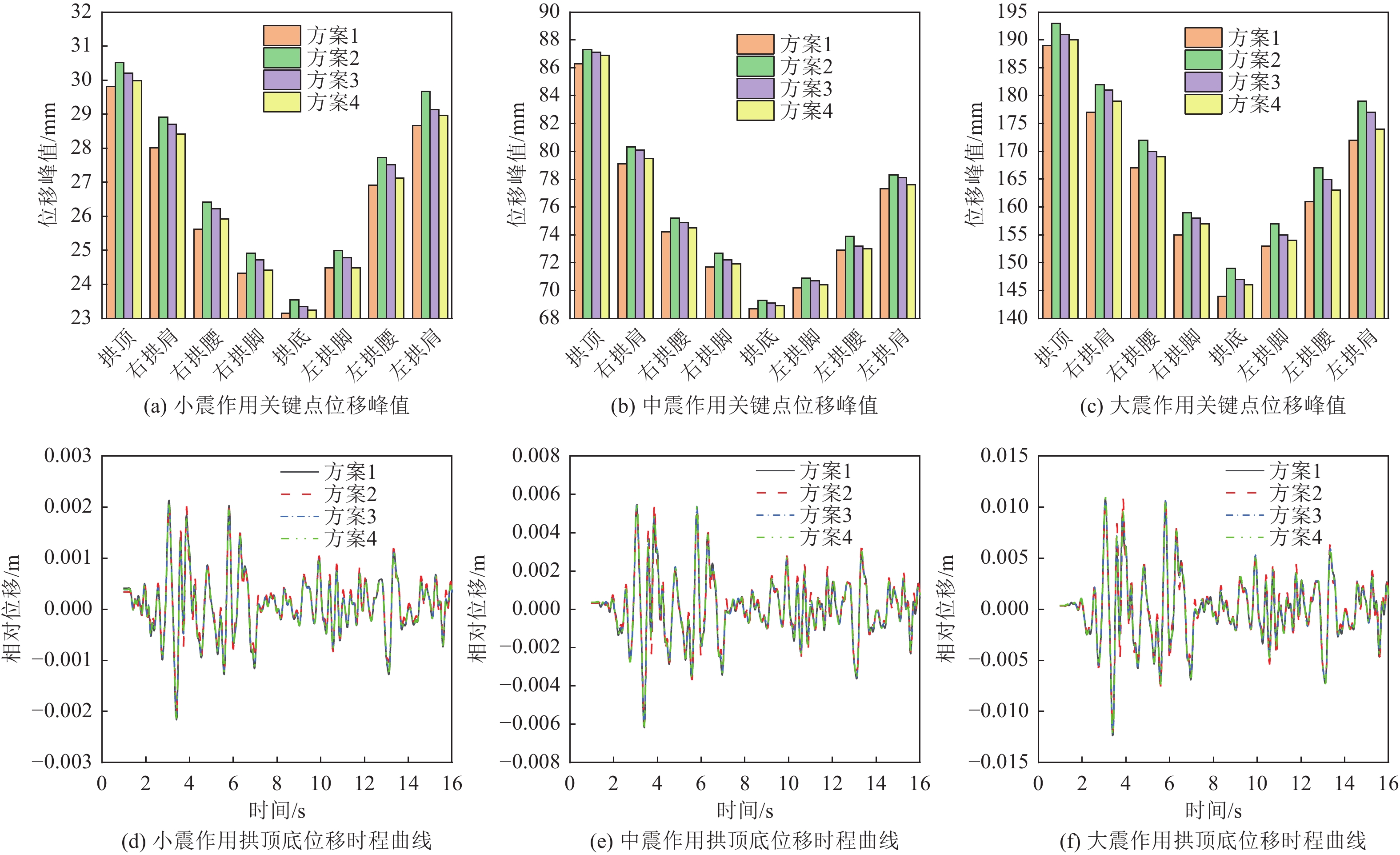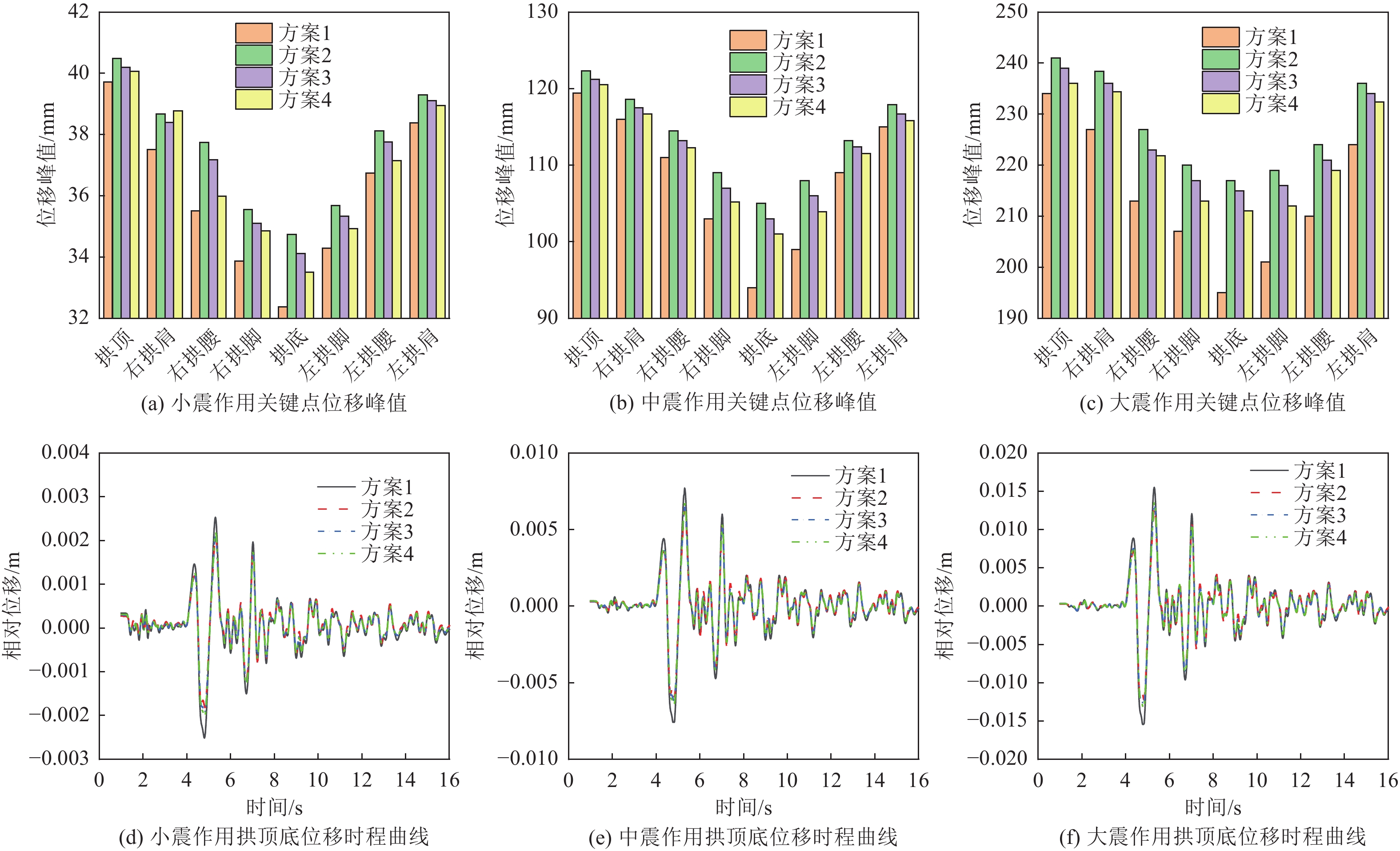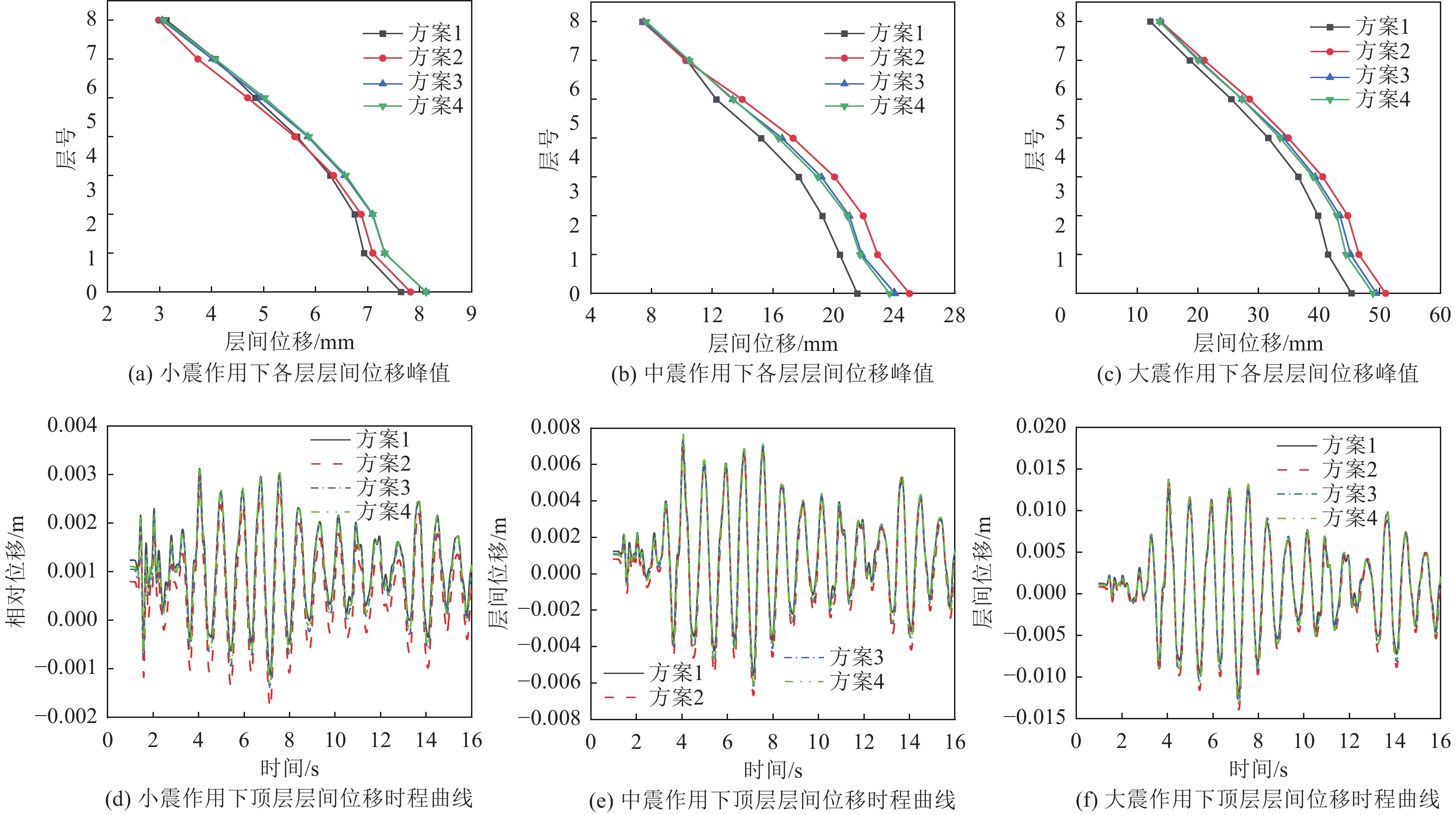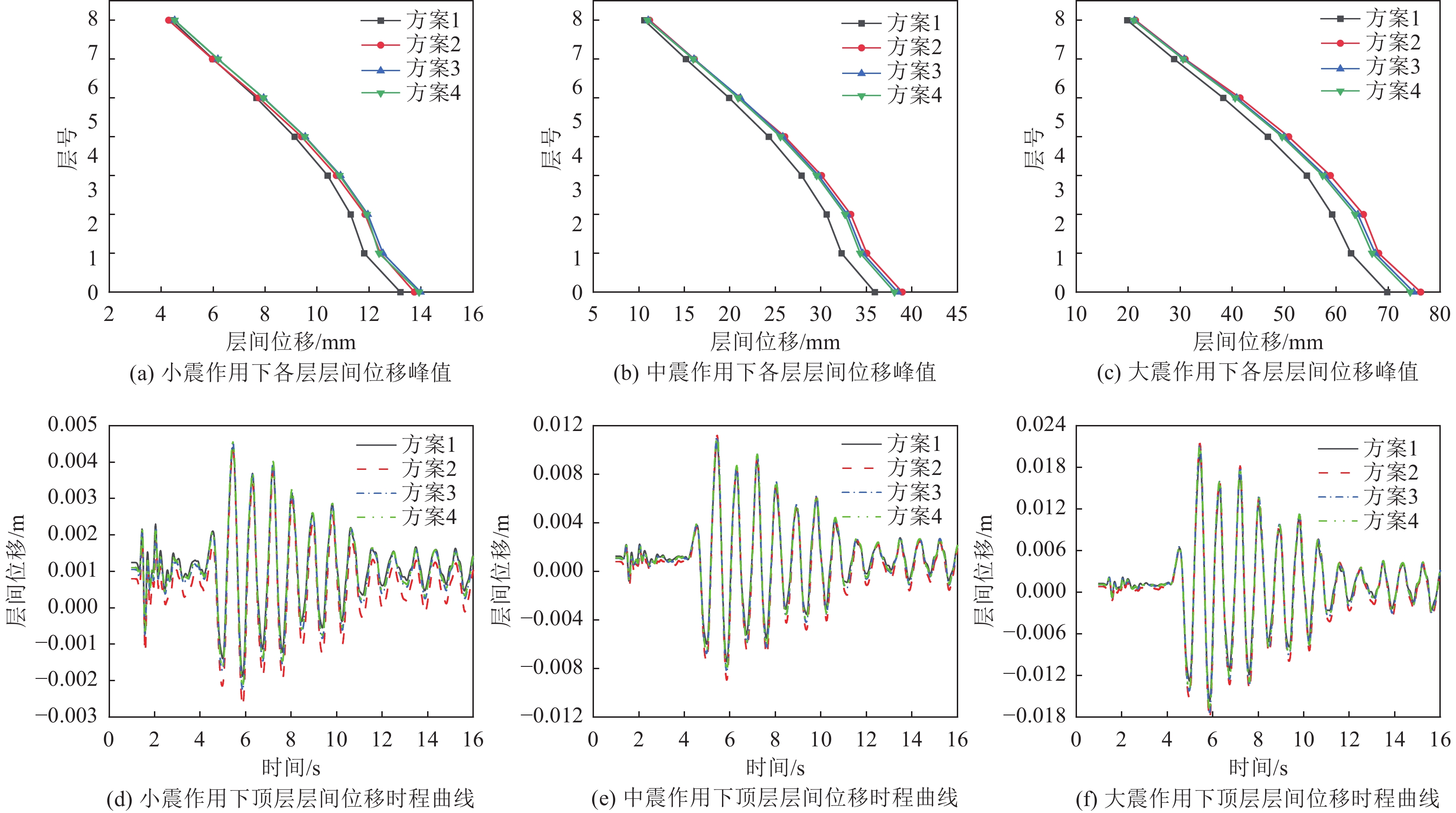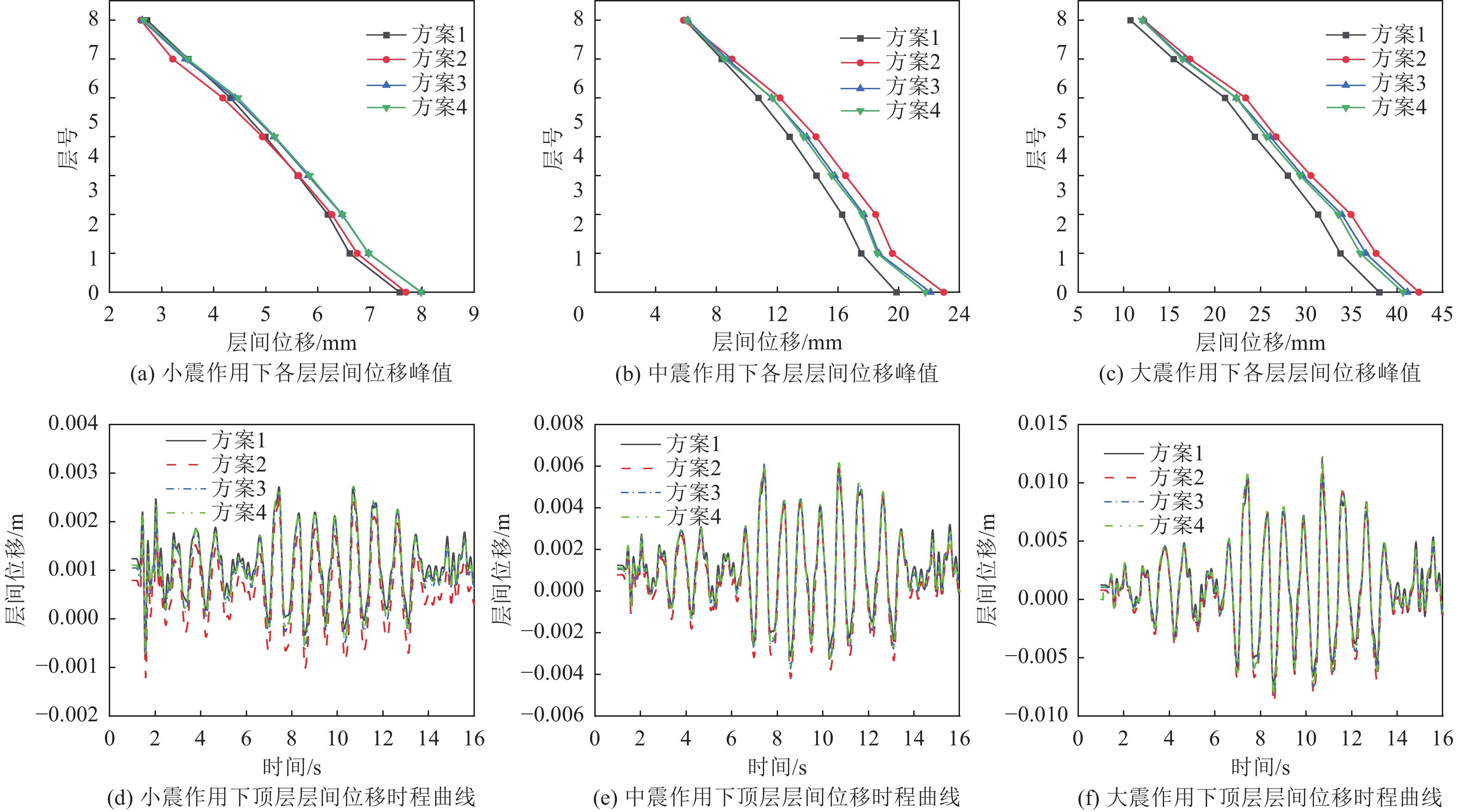Effect of Rubber Damping Layer on Seismic Response of Subway Tunnel and Adjacent Surface Buildings
-
摘要: 为研究在隧道处设置不同弹性模量的橡胶减震层对隧道-土-地表建筑相互作用体系的减震效果,运用ABAQUS有限元软件构建三维数值模型,对设置橡胶减震层前后体系中隧道及其邻近地表建筑地震响应进行比对分析。研究结果表明,设置橡胶减震层后,隧道地震响应明显降低,震级越低,减震效果越明显;橡胶弹性模量越小,减震效果越好。在0.05 g地震波作用下设置弹性模量为1 MPa的橡胶减震层时,隧道减震效果最佳。设置橡胶减震层后,地表建筑地震响应基本呈放大趋势,震级越高,放大效果越明显;橡胶弹性模量越小,放大效果越强。在0.30 g地震波作用下设置弹性模量为1 MPa的橡胶减震层时,地表建筑放大效果最为显著。在不同地震波作用下,设置橡胶减震层均会使隧道减震,地表建筑地震响应增加。Abstract: To investigate the seismic damping effect of rubber damping layers with varying elastic modulus on the tunnel-soil-surface building interaction system, a three-dimensional numerical model was developed using ABAQUS finite element software. The seismic responses of the tunnel and adjacent surface buildings were compared before and after the installation of the rubber damping layer. The results indicate that the rubber damping layer significantly reduces the seismic response of the tunnel, with the damping effect becoming more pronounced at lower seismic intensities. Additionally, a lower elastic modulus enhances shock absorption, with the most effective damping observed when a rubber layer with an elastic modulus of 1 MPa is applied under a 0.05 g seismic wave. However, the presence of the rubber damping layer leads to an amplification of seismic response in surface buildings, with the amplification effect increasing at higher seismic intensities. The lower the elastic modulus of the rubber, the stronger the amplification effect. The most significant amplification in surface buildings occurs when a rubber damping layer with an elastic modulus of 1 MPa is subjected to a 0.30 g seismic wave. These findings suggest that while the rubber damping layer effectively attenuates tunnel vibrations, it simultaneously amplifies the seismic response of surface buildings, emphasizing the need for careful consideration in its application under different seismic conditions.
-
表 1 材料力学参数
Table 1. Mechanical parameters of materials
名称 弹性模量/MPa 泊松比 密度/(kg·m−3) 土体 176.00 0.33 1 900 C30混凝土 3.00×104 0.15 2 450 C50混凝土 3.45×104 0.20 2 550 表 2 橡胶材料物理力学参数
Table 2. Parameters of the rubber materials
弹性模量/MPa 阻尼比 橡胶厚度/m 质量/kg 密度/(kg·m−3) 泊松比 1 0.25 0.5 3.297×106 1 000 0.38 6 0.25 0.5 3.297×106 1 000 0.38 10 0.25 0.5 3.297×106 1 000 0.38 -
陈国兴,陈苏,杜修力等,2016. 城市地下结构抗震研究进展. 防灾减灾工程学报,36(1):1−23.Chen G. X., Chen S., Du X. l., et al., 2016. Review of seismic damage, model test, available design and analysis methods of urban underground structures: retrospect and prospect. Journal of Disaster Prevention and Mitigation Engineering, 36(1): 1−23. (in Chinese) 陈健云,何伟,徐强等,2012. 地下结构对场地和地表建筑地震响应影响分析. 大连理工大学学报,52(3):393−398. doi: 10.7511/dllgxb201203014Chen J. Y., He W., Xu Q., et al., 2012. Analyses for effect of underground structure on seismic response of ground and adjacent surface buildings. Journal of Dalian University of Technology, 52(3): 393−398. (in Chinese) doi: 10.7511/dllgxb201203014 何川,封坤,方勇,2015. 盾构法修建地铁隧道的技术现状与展望. 西南交通大学学报,50(1):97−109. doi: 10.3969/j.issn.0258-2724.2015.01.015He C., Feng K., Fang Y., 2015. Review and prospects on constructing technologies of metro tunnels using shield tunnelling method. Journal of Southwest Jiaotong University, 50(1): 97−109. (in Chinese) doi: 10.3969/j.issn.0258-2724.2015.01.015 倪茜,卫林斌,2018. 减震层作用下地铁车站结构的三维减震分析. 西安科技大学学报,38(3):459−465.Ni Q., Wei L. B., 2018. Three-dimensional shock absorption analysis of metro station structure based on seismic layer. Journal of Xi'an University of Science and Technology, 38(3): 459−465. (in Chinese) 舒丞,吴永红,杜孟翔,2022. 基于粘弹性人工边界的掉层结构地震响应分析. 工业安全与环保,48(2):47−52. doi: 10.3969/j.issn.1001-425X.2022.02.011Shu C., Wu Y. H., Du M. X., 2022. Seismic response analysis of structure supported by foundations with different locations based on viscoelastic artificial boundary. Industrial Safety and Environmental Protection, 48(2): 47−52. (in Chinese) doi: 10.3969/j.issn.1001-425X.2022.02.011 王国波,王亚西,陈斌等,2015. 隧道–土体–地表结构相互作用体系地震响应影响因素分析. 岩石力学与工程学报,34(6):1276−1287.Wang G. B., Wang Y. X., Chen B., et al., 2015. Analysis of influencing factors on seismic responses of tunnel-soil-ground structure interaction system. Chinese Journal of Rock Mechanics and Engineering, 34(6): 1276−1287. (in Chinese) 韦浩浩,王国波,2019. 地下结构与不同刚度地表结构体系地震响应规律研究. 防灾减灾工程学报,39(2):258−264.Wei H. H., Wang G. B., 2019. Study on seismic response of underground structure and surface structure system of different stiffness. Journal of Disaster Prevention and Mitigation Engineering, 39(2): 258−264. (in Chinese) 卫林斌,2017. 地铁车站结构的抗震分析与减震技术研究. 西安:西安科技大学.Wei L. B., 2017. Study on seismic analysis and seismic reduction technology of subway station structure. Xi'an:Xi'an University of Science and Technology. (in Chinese) 张季,谭灿星,黄源等,2020. 地震作用下软土-隧道-地上框架体系动力反应分析. 振动与冲击,39(22):278−286.Zhang J., Tan C. X., Huang Y., et al., 2020. Dynamic response analyses of soft soil-tunnel-aboveground frame systems under earthquake. Journal of Vibration and Shock, 39(22): 278−286. (in Chinese) 张季,蒋玮,谭灿星等,2022. SV波斜入射时地铁车站-土-邻近地表框架结构动力相互作用分析. 震灾防御技术,17(4):622−631. doi: 10.11899/zzfy20220402Zhang J., Jiang W., Tan C. X., et al., 2022. Analysis on dynamic interaction of subway station-soil-aboveground frame structure under inclined incidence of SV wave. Technology for Earthquake Disaster Prevention, 17(4): 622−631. (in Chinese) doi: 10.11899/zzfy20220402 赵富发,江学良,杨慧等,2021. 橡胶减震层对浅埋偏压隧道地震加速度响应影响的试验研究. 应用力学学报,38(4):1622−1628. doi: 10.11776/cjam.38.04.B060Zhao F. F., Jiang X. L., Yang H., et al., 2021. Experimental study on the influence of rubber shock absorbing layer on seismic acceleration response of shallow buried bias tunnel. Chinese Journal of Applied Mechanics, 38(4): 1622−1628. (in Chinese) doi: 10.11776/cjam.38.04.B060 庄海洋,唐柏赞,余冰雁等,2023. 地下结构抗震与减隔震研究进展与展望. 震灾防御技术,18(1):1−12. doi: 10.11899/zzfy20230101Zhuang H. Y., Tang B. Z., Yu B. Y., et al., 2023. Review and prospect of earthquake resistance and seismic isolation of underground structures. Technology for Earthquake Disaster Prevention, 18(1): 1−12. (in Chinese) doi: 10.11899/zzfy20230101 Cao X. P., Zhang Y. P., Zhang Y. R., 2020. Anti-seismic effect of the shock absorption layer in tunnel. International Journal of Safety and Security Engineering, 10(1): 41−47. doi: 10.18280/ijsse.100106 Ghergu M., Ionescu I. R., 2009. Structure–soil–structure coupling in seismic excitation and “city effect”. International Journal of Engineering Science, 47(3): 342−354. doi: 10.1016/j.ijengsci.2008.11.005 Xin C. L., Wang Z. Z., Zhou J. M., et al., 2019. Shaking table tests on seismic behavior of polypropylene fiber reinforced concrete tunnel lining. Tunnelling and Underground Space Technology, 88: 1−15. doi: 10.1016/j.tust.2019.02.019 Xin C. L., Wang Z. Z., Yu J., 2020. The evaluation on shock absorption performance of buffer layer around the cross section of tunnel lining. Soil Dynamics and Earthquake Engineering, 131: 106032. doi: 10.1016/j.soildyn.2020.106032 Yang H., Jiang X. L., Lian P. Y., 2018. Seismic response of tunnel lining for shallow-bias tunnel with a small clear distance under Wenchuan earthquake. Advances in Civil Engineering, 2018: 2578062. doi: 10.1155/2018/2578062 Yang H., Liu C., Jiang X. L., et al., 2020. Shaking table test and numerical simulation for dynamic response of shallow-buried bias double-arch tunnel. Geotechnical and Geological Engineering, 38(4): 3915−3929. doi: 10.1007/s10706-020-01267-9 Zhou T. L., Dong C. S., Fu Z. P., et al., 2022. Study on seismic response and damping performance of tunnels with double shock absorption layer. KSCE Journal of Civil Engineering, 26(5): 2490−2508. doi: 10.1007/s12205-022-1862-y -



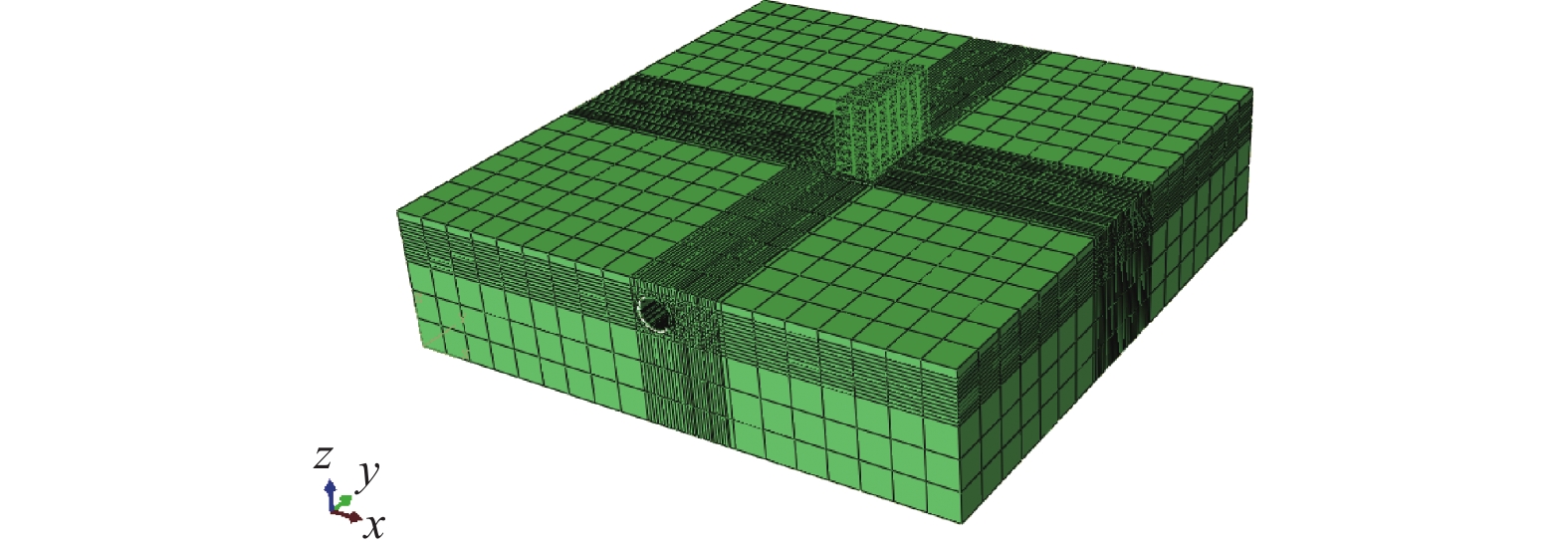
 下载:
下载:
